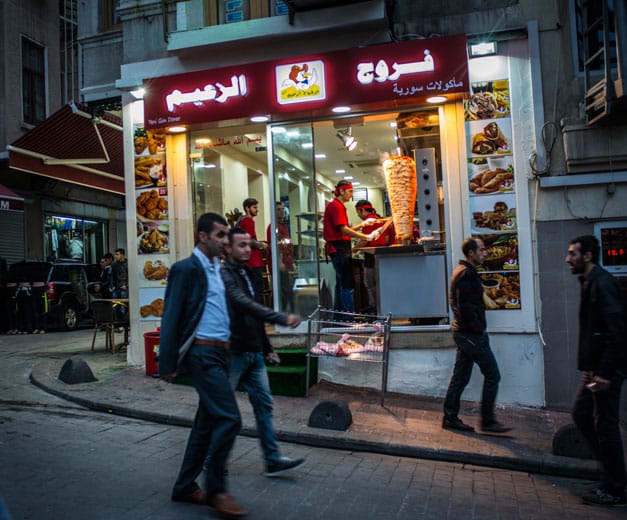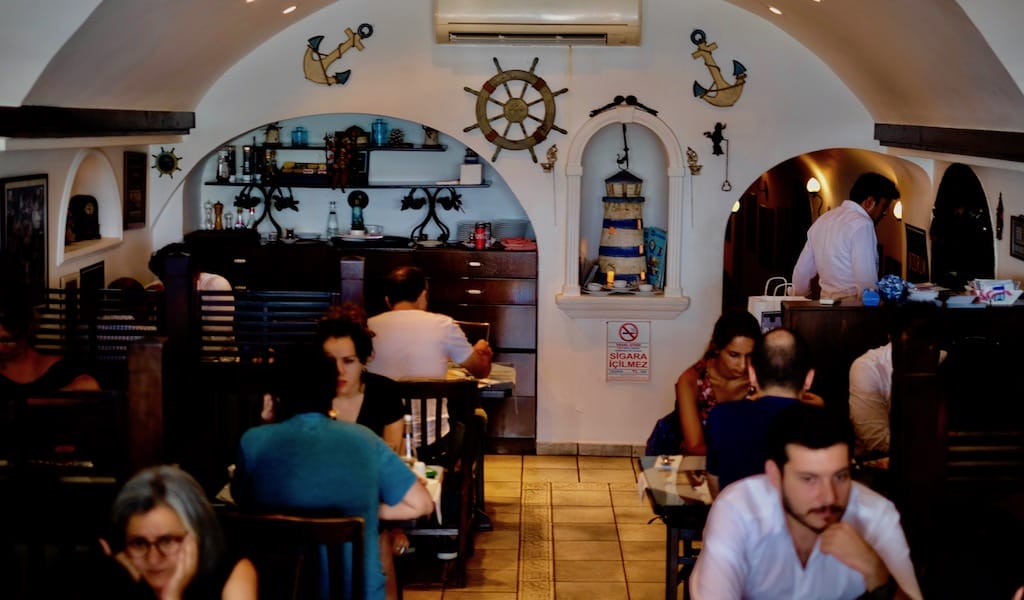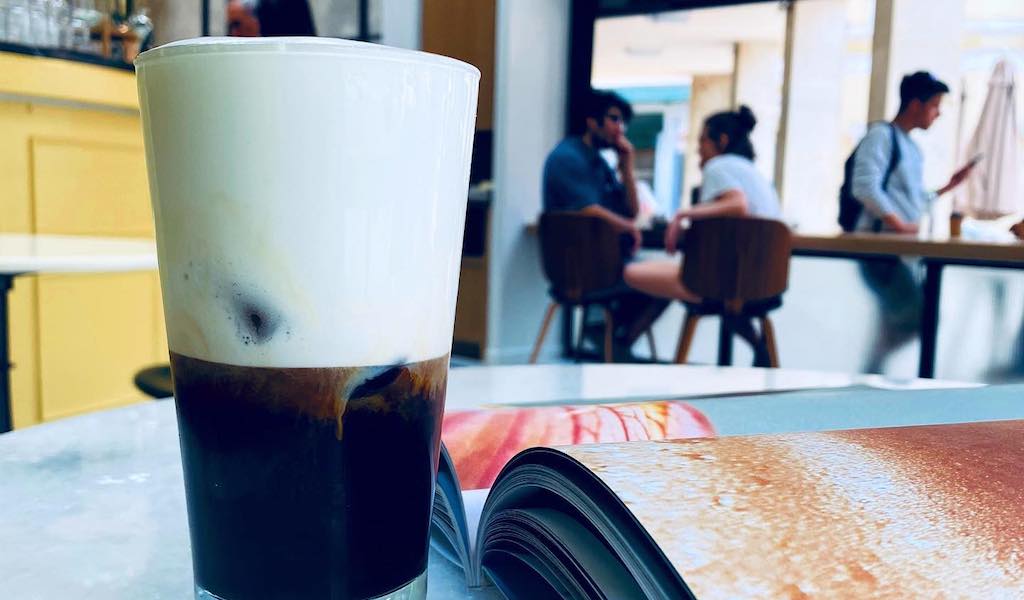Editor’s note: We regret to report that Farooj al Zaeem has closed.
Farooj al Zaeem is, pretty much, the best kind of restaurant made to resemble the worst kind of restaurant. If the neighborhood – one of Beyoğlu’s most unkempt snatches – doesn’t send you running, then the look of this place, like a knockoff polo shirt with misspellings, will signal that something here is not right.
Despite the wall of pre-folded fried chicken takeout boxes and all the signage dedicated to the house specialty, no one comes to this Syria-based chain without wiping a thin triangle of fresh pita through a few of the Syrian specialties, which are all executed so well here. Though the whole vibe of the place – cramped interior, cartoony sheriff rooster logo, uniformed staff, enlarged food photos with a corporate sheen – would tell you otherwise, this is actually a place where Syrians come to get proper, freshly made food that tastes like home. Zaeem is so authentically Syrian that some just pass through to say hello the Syrian way, a quick handshake and a kiss of the fingers.
With great interest, we’ve tracked the rise of Syrian restaurants in Istanbul, mainly in the Aksaray district. But not until Zaeem did we have that what-have-I-been-missing feeling that usually inspires us to try copying the food at home and, failing that, become a regular of the place. Zaeem’s signature move is a very generous application of garlic, tahini and lemon.
Let’s face it: Turkey lies well north of the world’s hummus belt. The Middle Eastern linchpin of chickpeas, garlic, lemon, oil and tahini does not resonate here. Turks will tell you: This is not the Middle East. Exhibit A? Bum hummus. Zaeem’s hummus was ultrasmooth, with a tahini-centric, garlicky smack, looking vaguely like something you might find on a meze tray around town but tasting entirely exotic.
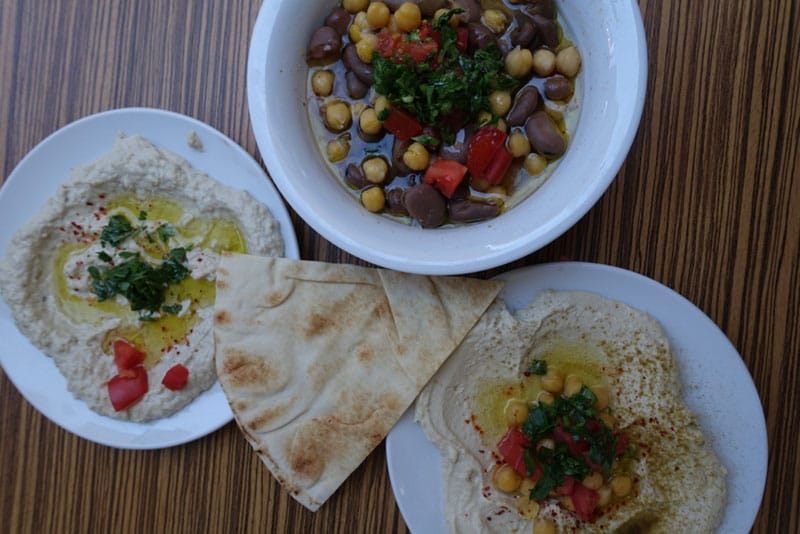
The chicken shwarma is another case of mistaken identity. We expected nothing much more than the same tavuk döner sold at corner shops all over the neighborhood. This one had a different spicing and a powerful lemony tang. We solicited the dönerci, Muhammed, from the city of Homs, for more information on the marinade, but he would only tell us that there were “12 to 16 spices” used. But it would be unfair to give all of the credit to the shwarma; equally seductive was the toum krem, a house-made garlic mayonnaise (which stands at a close second behind Greek tzatziki in the category of greatest condiments for döner-style sandwiches), which we lathered on every bite.
Mutabbal added the element of smoky mashed eggplant and yogurt tang to the previously noted trio, while ful, plump fava beans topped off with chickpeas, was more focused on the bright lemon and garlic side of the story. All were garnished artfully with chopped tomato and parsley.
The fetteh, Zaeem’s pièce de résistance, was topped with deep-fried pita chips and peanuts on one occasion and nude on another. Turning around to ask what happened to the topping, we were nearly scalded as a cook sauntered over to pour sizzling clarified butter on our fetteh. Fetteh is a layered dish, and, fried pita aside, the textural differences between those layers can be very subtle – yet crucial to fully enjoying fetteh, so please don’t go churning up your fetteh with a spoon like it’s a bowl of common mercimek çorbası. Fishing from the bottom of the strata, we drew up chicken broth-soaked bread and shreds of soft chicken coated in a tahini-yogurt sauce that hung around the top. Going shallow, we found a pocket of chickpeas under the sauce and snagged a pita chip from the surface. Please pay attention: There are 1,001 unique bites in this monochromatic bowl.
The standard against which we measure all fetteh was a heaping bowl we had years ago at a simple lunch spot in Damascus. We can’t recall how every bite of that fetteh went, but the lasting memory is of a dish that that crosses the best elements of chicken soup with those of hummus, and Zaeem’s presentation was all that.
Befuddled by the apparent care and utter unfastfoodness each dish was made with, we pressed the kitchen for answers. Muhammed, a waiter from the Syrian port of Latakia, told us that this was in fact a Syrian chain with a location in Ain Tarma and one in Yarmouk. “It is quite typical Syrian fast food,” he said in perfect English. Leaving us with one more serious question: Did they miss the memo on fast food or did we?
Does a chain restaurant have to represent everything that’s wrong with the processed food world and its evil industries? Did this directive never reach Syria? The boys at Zaeem don’t think there’s anything strange about making fresh food fast in a Chick-fil-A-like setting. If the food is good, who cares?
That’s inspiring. We only hope that peace will one day settle over the hummus belt so we might test this theory.
 August 8, 2017 Bodrum Mantı
August 8, 2017 Bodrum Mantı
Editor’s note: This is a golden oldie that we wrote about a while back but still enjoy. […] Posted in Istanbul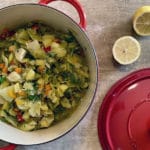 October 23, 2020 Recipe
October 23, 2020 Recipe
A part of the Allium family, which also includes onions and garlic, leeks (prasa, πράσα, […] Posted in Athens August 28, 2020 Liquid Assets
August 28, 2020 Liquid Assets
It was August 31, 1957, and Yiannis Dritsas, a representative of Nestlé Greece, was at […] Posted in Athens
Published on October 27, 2014
Related stories
August 8, 2017
IstanbulEditor’s note: This is a golden oldie that we wrote about a while back but still enjoy. Sadly, the Arnavutköy location is no longer open. There are several other locations around Istanbul, though, which can be found here. From Western China all the way to Istanbul, Turkic people roll out dough, fold it into small…
October 23, 2020
AthensA part of the Allium family, which also includes onions and garlic, leeks (prasa, πράσα, in Greek) are native to the Middle East and the eastern Mediterranean region. The hardy crop has been widely used since at least the second millennium B.C., first by the ancient Egyptians and Mesopotamians and later by the Greeks and…
August 28, 2020
AthensIt was August 31, 1957, and Yiannis Dritsas, a representative of Nestlé Greece, was at the 22nd Thessaloniki International Fair. His mission? To present a new iced chocolate drink for kids. It was simple, really: add milk and cocoa powder to a shaker (essentially a cocktail shaker), shake well and serve. During a break, an…







































